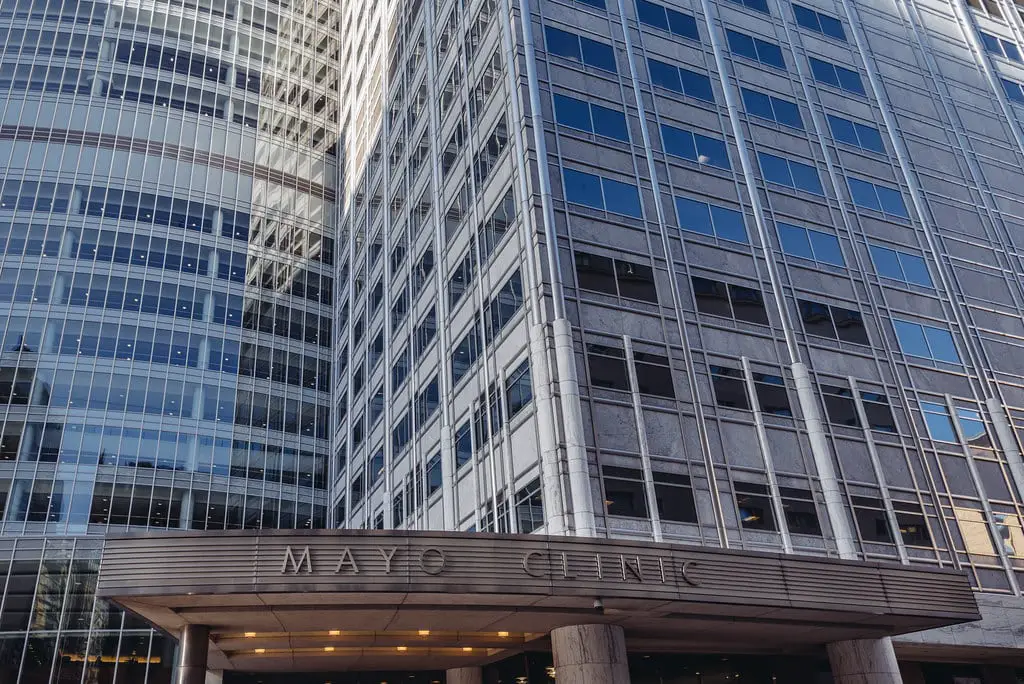The Mayo Clinic, founded by William Worrall Mayo and his sons Will and Charlie, has grown from a small medical practice in Rochester, Minnesota, to a world-renowned academic medical center.
Today, it operates major campuses in Rochester, Phoenix/Scottsdale, Arizona, Jacksonville, Florida, and a facility in central London, UK, acquired in 2020. In addition, the Mayo Clinic Health System also includes Minnesota, Wisconsin, and Iowa affiliated facilities.
Core Strengths and Offerings
Integrated Health Care
- Mayo Clinic’s focus on integrated health care allows for coordinated, comprehensive patient care, often resulting in better outcomes.
- The practice is well-known for its tertiary care and destination medicine, specializing in treating complex cases.
Education
- The prestigious Mayo Clinic Alix School of Medicine ranks within the top-15 medical schools in the United States.
- Mayo Clinic offers some of the country’s most highly-regarded residency education programs.

Research
- Mayo Clinic allocates over $660 million yearly to research, employing more than 3,000 full-time research staff.
- This commitment to research has led to groundbreaking discoveries and improvements in patient care.
Accolades and Achievements
- Mayo Clinic has held the number one spot on the U.S. News & World Report’s Best Hospitals Honor Roll for seven consecutive years and has remained at or near the top for over 35 years.
- It has been featured on Fortune magazine’s “100 Best Companies to Work For” list for 14 consecutive years through 2017.
- The clinic is among the leaders in the United States for the number of transplants performed, including solid organ and hematologic transplantation.
Mayo Clinic: Core Operations in Clinical Practice, Research, and Education
Clinical Practice
In 2018, Mayo Clinic served over 1.2 million patients from all 50 states and 138 countries, with many referrals from smaller clinics and hospitals.
The clinic is renowned for its highly specialized medical care. Notably, Mayo Clinic physicians receive a fixed salary, unlinked to patient volume or fee-for-service payments, encouraging them to spend more time with each patient.
Research Initiatives
Mayo Clinic is committed to advancing the understanding of disease processes and clinical best practices and translating laboratory findings to clinical practice. As of 2018:
- 254 full-time scientific faculty members;
- 766 research-active physicians;
- 4,027 full-time research personnel;
- 3,067 newly approved human research studies;
- 12,760 ongoing human research studies;
- 9,275 research publications and review articles.
All internal medicine residents across Mayo Clinic’s three campuses have published research during their tenure in recent years.
Education: Mayo Clinic College of Medicine and Science (MCCMS)
Founded in 1915, MCCMS provides educational programs integrated with Mayo Clinic’s biomedical research activities and clinical practice. The college comprises five accredited schools:
- Mayo Clinic Alix School of Medicine: Grants M.D. degrees;
- Mayo Clinic Graduate School of Biomedical Sciences: Offers master’s and Ph.D. degrees;
- Mayo Clinic School of Health Sciences: Provides training for around 60 health sciences career fields;
- Mayo Clinic School of Graduate Medical Education: Offers over 300 residency and fellowship programs across all medical and surgical specialties;
- Mayo Clinic School of Continuous Professional Development: Offers continuing education courses for practicing medical professionals.
Mayo Clinic: A Journey from Humble Beginnings to Global Healthcare Leader
Early Years and Formation
The Mayo Clinic originated with the medical practice of Dr. William Worrall Mayo, who immigrated to the United States from England in 1846. In 1864, he opened a private medical practice in Rochester, Minnesota. Both his sons, William James Mayo and Charles Horace Mayo, later joined the practice.
After a devastating tornado hit Rochester in 1883, the Mayo family joined forces with the Sisters of Saint Francis to establish Saint Marys Hospital in 1889, where all three Mayo doctors served on staff.
Development of Group Practice
In the 1890s, the Mayo brothers invited other physicians to join their practice, laying the foundation for integrated multispecialty practice. The early physicians included Christopher Graham, Augustus W. Stinchfield, Henry Plummer, Melvin C. Millet, E. Star Judd, and Donald Balfour.
Dr. Henry Plummer played a crucial role in developing systems and procedures that remain at the core of Mayo Clinic today.

Growth and National Expansion
In 1919, the Mayo brothers donated their assets and savings to transform the private partnership into a not-for-profit organization focused on patient care, medical education, and medical research. After World War II, Mayo Clinic continued to expand in Rochester, Minnesota.
In 1986, Mayo Clinic officially merged with Saint Marys Hospital and Rochester Methodist Hospital. The same year, it expanded to Jacksonville, Florida, followed by Scottsdale, Arizona, in 1987 and Phoenix, Arizona, in 1998. In 1992, the Mayo Clinic Health System began offering community-based medical services in Minnesota, Wisconsin, and Iowa.
Global Expansion
In 2011, Mayo Clinic launched the Mayo Clinic Care Network, connecting facilities with Mayo Clinic protocols and experts. In November 2019, it invested $50 million in a joint partnership with SEHA Abu Dhabi Health Services Co for a 25% stake in a 741-bed hospital in the UAE.
In 2020, Mayo Clinic opened a healthcare facility in central London in partnership with Oxford University Clinic, which later became the facility’s sole owner, operating as Mayo Clinic Healthcare.
Mayo Clinic: Pioneering Contributions to Medicine and Science
Multispecialty Group Practice and Medical Innovations
In the early 20th century, Henry Plummer developed Mayo Clinic’s multispecialty group practice model and integrated medical record system, enabling better information sharing among physicians.
Plummer also contributed to innovations in building systems, such as steam sterilization rooms, metal surgical tools, pneumatic tube systems, and knee-operated sinks. In 1905, Mayo Clinic advanced a technique of using frozen tissue during surgery to determine cancer diagnoses while patients were still in the operating room.

Medical Education and Research Milestones
Mayo Clinic offered the first graduate medical education program in 1915 and established the first nonprofit practice aligned with medical education and research. In the 1920s, Albert Compton Broders created the first index to grade tumors. Mayo Clinic opened the first hospital-based blood bank in Rochester in 1935.
High-Altitude Mask and G-Suit Development
In the 1930s, Mayo Clinic associates Arthur H. Bulbulian, Randolph Lovelace, and Walter M. Boothby developed the BLB flight mask, a high-altitude mask for oxygen therapy. During World War II, Mayo Clinic researchers developed the G-suit to prevent blood pooling in pilots’ legs during high G forces.
Nobel Prize in Medicine and Surgical Advancements
In 1950, Mayo Clinic physicians Philip S. Hench and Edward C. Kendall and Swiss chemist Tadeus Reichstein were awarded the Nobel Prize in medicine for discovering cortisone.
In the same decade, Mayo Clinic began using and refining the Gibbon heart-lung machine, now known as the Mayo–Gibbon heart-lung machine.
Lambert–Eaton Myasthenic Syndrome and Hip Replacement
In 1956, Mayo Clinic physicians Lealdes (Lee) McKendree Eaton, Edward Howard Lambert, and Edward Douglas Rooke described the clinic and electrophysiological findings of Lambert–Eaton myasthenic syndrome. In 1969, Mayo Clinic doctors performed the first FDA-approved hip replacement in the United States, and in 1973, they acquired the first CT scanner in the U.S.
Anthrax Detection and Regenerative Medicine
In 2001, Mayo Clinic and Roche Molecular Biochemicals developed a rapid DNA test to detect anthrax in humans and the environment. In 2013, Mayo Clinic specialists in regenerative medicine began the “first-in-human study” using patient cells to attempt to heal heart damage.
Mayo Clinic Center for Innovation and Partnerships
Established in 2008, the Mayo Clinic Center for Innovation has worked on over 270 projects. In 2014, Mayo Clinic partnered with Apple to develop the Apple Health and HealthKit apps. In 2015, Mayo Clinic and Delos Living launched the Well Living Lab, a research facility designed to study the interaction between indoor spaces and human health.

Architectural Evolution and Art Collection
Mayo Clinic’s campus has expanded significantly, starting with the 1914 “red brick” building, the world’s first building designed for multispecialty group practice.
Later additions include the Plummer Building, listed on the National Register of Historic Places, and other notable buildings like the Mayo Building (1955), Guggenheim Building (1974), Gonda Building (2001), Opus Imaging Research Building (2007), and Discovery Square building (2019).
The Plummer Building features bronze entry doors designed by artist Charles Brioschi, weighing 4,000 pounds each, and closed to memorialize significant historical events.
Over the decades, Mayo Clinic has established an extensive art collection, with works by renowned artists such as Andy Warhol, Auguste Rodin, Alexander Calder, Ivan Meštrović, Dale Chihuly, Jennifer Bartlett, Joan Miró, Tuck Langland, and Paul Granlund.
Educational Programs and Mayo Clinic College of Medicine and Science
In 1915, Mayo Clinic developed its first medical and educational programs with the assistance of the University of Minnesota. Today, the Mayo Clinic College of Medicine and Science has five schools: Mayo Clinic School of Health Sciences, Mayo Clinic Alix School of Medicine, Mayo Clinic School of Continuous Professional Development, and Mayo Clinic Graduate School of Biomedical Sciences.
Mayo Clinic’s Current Practice and Leadership
Mayo Clinic rules mandate that its CEOs be physicians from within the organization. John H. Noseworthy, M.D., was president and CEO from 2009 to 2019. Under his leadership, Mayo Clinic underwent significant expansion, including the launch of the Destination Medical Center, a 20-year economic growth plan in Rochester.
In 2018, Gianrico Farrugia, M.D., a Mayo Clinic physician for over 30 years, replaced Noseworthy as CEO. By 2018, doctors at Mayo Clinic treated around 1.3 million patients yearly.

Mayo Clinic: Pioneering Innovation in Healthcare
Technological Advancements and Partnerships
Mayo Clinic continues to lead in medical innovation by conducting clinical trials, offering groundbreaking therapies like CAR-T and proton therapies, and being a prominent research center for the COVID-19 epidemic. In addition, they were among the first institutions to offer plasma exchange for COVID-19 patients.
Mayo Clinic has adopted over 15,000 Apple mobile devices for patient care and developed the Synthesis Mobile app to integrate hundreds of health systems. Additional apps were created for Mayo Clinic Care Network members to access medical records or seek clinician assistance.
Well Living Lab and Center for Innovation
In collaboration with real estate firm Delos Living, Mayo Clinic launched the Well Living Lab in 2015, a research facility designed to study the interaction between indoor spaces and human health in non-hospital environments.
The Mayo Clinic Center for Innovation, established in 2008, has worked on over 270 projects and serves as a role model for using design in healthcare.
Strategic Collaborations and Investments
In March 2018, Mayo Clinic partnered with healthcare education system company Mytonomy to provide video content for cancer patients, addressing essential questions and aiding the decision-making process between patients and doctors.
Mayo Clinic entered a strategic partnership with Google in September 2019 for healthcare innovation and cloud computing, with Google planning to open a facility in Rochester, Minnesota, for Mayo Clinic.
In January 2020, Mayo Clinic and NTT Venture Capital joined a $60 million financing round for biomedical software startup inference.

Consistent Top Rankings in Healthcare
Since 2016, Mayo Clinic in Rochester has been consistently ranked as the #1 general hospital in the United States by U.S. News & World Report. In addition, of nearly 5,000 hospitals considered and ranked across 16 specialties, Mayo Clinic Rochester was in the top 10 for all but one specialty, in the top 4 for 13 specialties, and ranked #1 in 8 of the 12 data-driven specialties.
In addition to specialty rankings, Mayo Clinic was one of fewer than 70 hospitals to score High Performing in every category of the nine individual measures for standard procedures and conditions. In addition, Mayo Clinic was the only hospital on the 2016–2017 Honor Roll to receive five stars from CMS.
All Mayo Clinic hospitals received an “A” safety rating from Leapfrog in its April 2017 report. In addition, in 2021–22, Mayo Clinic Rochester was again ranked as the #1 overall hospital in the United States by U.S. News & World Report.
